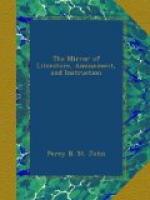OLD SARUM
[Illustration]
Among the earliest antiquarian records, Old Sarum is described as a city of the Belgae; and its historical details have proved an exhaustless mine for the researches of topographical illustrators.
Thus, Sir R.C. Hoare describes it as “a city of high note in the remotest periods by the several barrows near it, and its proximity to the two largest Druidical temples in England, namely, Stonehenge and Abury."[1]
The Romans held it as a strong military station, and it was admitted to the privileges of the Latin law, under the name of Sorbiodunum;[2]
Under the Saxons it ranked among the most considerable towns of the West kingdom, and possessed ecclesiastical establishments soon after the conversion of the Saxons to Christianity.[3]
In the early part of the ninth century it was the frequent residence of Egbert; and in 960, Edgar assembled here a national council to devise the best means of repelling the Danes in the north.[4]
Arthur commanded it to be more strongly fortified by another trench and high palisadoes.[5]
In 1086, William the Norman convened in this city the prelates, nobles, sheriffs, and knights of his new dominions, there to receive their homage;[6] and probably, within its walls was framed the feudal law, as Domesday Book was commenced in the same year.
Two other national councils were held here; one by William Rufus, in 1096, and another by Henry I in 1116.[7]
Peter of Blois, an early ecclesiastical writer, described Old Sarum as “barren, dry, and solitary, exposed to the rage of the wind; and the church (stands) as a captive on the hill where it was built, like the ark of God shut up in the profane house of Baal."[8]
Such are a few of the chronological data of the principal events in the history of Old Sarum; these, however, will suffice to elucidate the antiquity of the city, and from their historical importance cannot fail to make the preceding engraving a subject of general as well as of local interest, especially as it represents the old city, previous to its reduction in 553.
Scarcely a vestige of human habitation now remains of Old Sarum, as we have shown once a place “of great importance—and a city adorned with many proud structures—a splendid cathedral and other churches—a castle with lofty towers and ramparts—regular streets and houses—and once the residence of a numerous population.” But all these have passed away, and nought is left to tell the tale of their greatness, but a few crumbling wrecks of massy walls; whilst vast fosses and elevated ramparts remain to mark it as the site of desolating war. The contrast of time-worn ruins with their surounding scenes of luxuriant nature is affecting even to melancholy. A recent visiter to the area of Old Sarum describes “a field of oats flourishing on the very spot where the crowded street had formerly extended itself; and a barrier existing to the further progress of agriculture, by the remains of the cathedral, castle, &c. forming heaps of rubbish barely covered with scanty and unprofitable verdure.”




